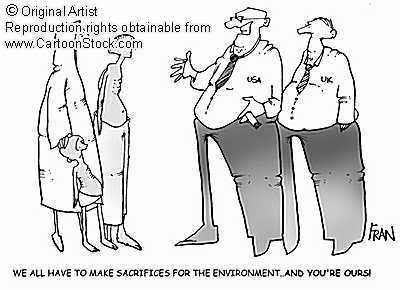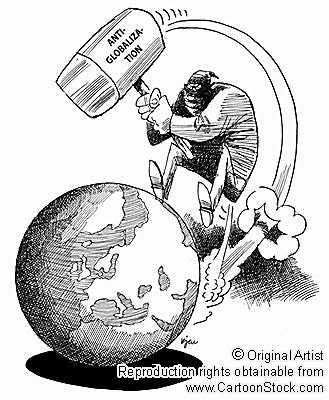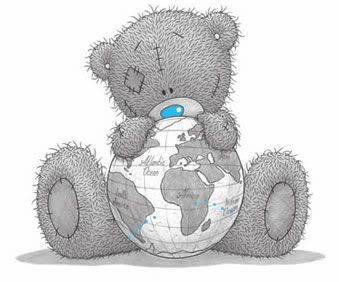Tuesday, May 15, 2007
With reference to
here (:
This article states that Bird flu may only be a small thing part of something much more massive than the already dangerous H5N1 virus. Experts in Mali cited global warming and increased travel and trade as factors improving the dangerous microbes' breeding and spreading.
Francois Le Gall, the World Bank's leading livestock specialist for Africa, mentioned that there was a new disease appearing almost every year, 75 percent of these from animals, and 80 percent with zoonotic potential. Diseases the are zoonotic are animal diseases that humans also can catch. Microbes now are also able to cross the world in a few hours, spreading their germs everywhere. This, I believe could have stemmed from the world being 'hooked on speed'.
The article also mentions that 'globalisation...it's a good thing, but it brings with it new risks. We have to be prepared.'
But how do we be prepared?
Do we just simply wash our hands with Dettol before and after every meal? Do we spray insecticide everytime we go out? Do we stuff a fly swatter down the back pocket of our jeans? Do we stay away from bird meat?
I suggest we don't just do anything we can to keep only ourselves safe. The 10-minute mozzie wipeout may only be known to people in Singapore; are others worldwide doing the same to help prevent dengue? If not, how can we help it when dengue spreads to our own country?
As for bird flu, the countries where the Avian influenza first begins should already be on their guard, watching pigs, chickens, animals overall for any sign of the flu.
As such, when symptoms are spotted, neigbouring countries can be informed and warned, and the number of casualties from this flu will decrease.
Labels: Eadelin Chantelle Y Dizon
Siddy goes global
@ 11:17 PM
+ + + + + + + + +
With references to
here (:
The Medical Journal of Australia states that Globalisation is most accurately defined in terms of 3 changes: spatial, temporal and cognitive changes.
According to the MJA, spatial change affects how we view and experience physical or territorial space. Over time, national borders have come to be rendered irrelevant, as drug-trafficking, cigarette smuggling and global climate change begin to challenge the capacity of governments to effectively regulate them. In terms of health, spatial change leads to a rise in the number of migrants throughout the world. It would be overly simplistic and inaccurate to describe globalisation as either “good” or “bad” for health. In nations with high income, the debate surrounding globalisation and health tends to focus on the perceived threat, from low- and middle-income countries, of acquiring certain acute and epidemic infections, such as AIDS and SARS. They also fear the potential financial burden of unhealthy populations migrating from the developing world. High-income countries may also export to other parts of the world products like tobacco and fast food, indirectly affecting foreign direct investment and debt burdens.
Temporal change affects how we perceive and experience time. Social interaction is speeding up through modern communication and transportation technologies. We are hooked on speed, wanting to do everything quickly. However, our lives are slowed down by modern complexities. It affects the spread of disease. The speed of modern transportation systems means that infections can potentially move around the world within a few hours (take the SARS outbreak in 2002–03 for example). However, also due to the increase in speed, modern technology potentially enables us to respond more quickly to such emergencies. Some leaders of the global healthy community are the World Health Organization (WHO) who, according the
website, is responsible for providing leadership on global health matters, shaping the health research agenda, setting norms and standards, articulating evidence-based policy options, providing technical support to countries and monitoring and assessing health trends.
Cognitive change is influencing how we see ourselves and the world around us. The main changes here occur in the mass media, the advertising industry, consultancy firms, research institutions, political parties, religious groups and other institutions seeking to win people's “hearts and minds”. In the process, our cultures, wants and needs, and other aspirations are being changed. The MJA states that cognitive changes have facilitated the global spread of “lifestyle” diseases (for example, obesity) in certain populations within low- and middle-income countries. The spread of health sector reform can also be seen as a form of cognitive globalisation in terms of transferring policies about health service provision and financing across the world.
One has to understand that the impacts of Globalisation on health can be both positive and negative, depending on the factors, some of which are geographical location, sex, age, ethnic origin, education and consequently socioeconomic status.
I propose that in order to maximize Globalisation and put it to use in the best way possible, scientists and researches keep up the good work with the research on vaccines and possible cures for diseases which can spread worldwide, so as to avoid further catastrophe, like the SARS outbreak 4-5 years ago.
Labels: Eadelin Chantelle Y Dizon
Siddy goes global
@ 10:48 PM
+ + + + + + + + +
Now I am going to talk about something related to my previous post, the globalizing standard of beauty. Vogue, the fashion equivalent to the holy bible is an example which shows the globalizing standard of beauty. Vogue began as an American magazine, but now, there are different editions of Vogue published around the world including Australia, Brazil, China, France, Germany, Greece, India, Italy, Korea, Japan, Mexico, Portugal, Russia, Spain, Switzerland, Taiwan, and the United Kingdom. Vogue is featured in many countries but the models do not appear only in their country’s edition of Vogue but also the other international versions! Vogue not only brings fashion together but also the many different standards of beauty together.
 The covers of some international editions of Vogue
The covers of some international editions of VogueModeling itself has also become increasingly globalize. In the past the industry will only have a single token colored model in runway shows, editorials or its advertising campaigns but now it is breaking away from tokenism and more and more ethnic models are making it big! Out of the current group of ‘IT’ girls, a hand few of them are Asian, like Chinese Du Juan and Pei Bei; Koreans Hye Park, Han Hye Jin and Daul Kim; Japanese, An Watanabe; and Russian Eugena Manchieva. There has also been an increasing group of ethnically diverse models like Korean/African-American teen queen, Chanel Iman who was featured in the US Vogue May 2007 cover, The World’s Next Top Model which also featured clothes from Gap’s Designs Edition (as mentioned above) and the racially ambiguous Bruna Tenorio. Modeling allows one to see not only the beauty of one’s on culture but also introduces one to another standard of beauty.


 Hye Park, Hye Jin and Du Juan at the SS07 Dolce and Gabbana fashion show.
Hye Park, Hye Jin and Du Juan at the SS07 Dolce and Gabbana fashion show.Your Cultural Expert, Nicholas!
Labels: Nicholas Chua - Culture Expert
Siddy goes global
@ 8:49 PM
+ + + + + + + + +
Today I am going to talk about the globalization of Fashion. Fashion is universal and transcends not only the different regions but also the different eras. Fashion which was once predominantly French and European has now globalized into an international affair. One example to illustrate my point would be how there are fashion weeks not only in European countries any more. Right now, there are fashion weeks in South Africa, Brazil, China, India and also our very own Singapore! By having more fashion weeks around, it is not only encouraging more emerging designers from their respective countries to step out and show their collection but also bringing the collections from the more prestigious fashion capitals to the locals!
Gap, an American clothing and accessories retailer based in San Francisco, California and founded in 1969 by Donald Fisher and Doris Fisher, is also putting in its best effort to globalize fashion. Gap has recently came to Singapore with stores in Vivo City and Wisma Atrium. As of October 2006, Gap Inc. had approximately 150,000 employees and operated 3,139 stores worldwide not only in the United States, but also Canada, Mexico, France, Germany, Ireland, Japan, Malaysia, Indonesia and United Kingdom. Gap has also recently enlisted 2006 CFDA/Vogue Fashion Fund winners Doo-Ri Chung of Doo.Ri, Kate and Laura Mulleavy of Rodarte, and Thakoon’s Thakoon Panichgul to design a limited-edition collection of specially designed pieces that will be sold at Gap stores. Out of the 4 designers, 2 of them are Asian and this proves my point on how fashion is globalizing and giving more people from different cultures equal opportunities to experiment.
http://www.fashionweekdaily.com/Scene/fullstory.sps?iNewsid=420461&itype=8488The designers in the ad campaign with their models, Doo-Ri Chung of Doo.Ri, Thakoon’s Thakoon Panichgul, and Rodarte sisters Kate and Laura Mulleavy.Your Cultural Expert, Nicholas!
Labels: Nicholas Chua - Culture Expert
Siddy goes global
@ 8:27 PM
+ + + + + + + + +
The poor as sacrifices for globalization?Vivian Choy, Economic Expert
Cartoon from
CartoonstockThis cartoon very accurately depicts the exploitation of the poor, who have to make way for globalization. In this case I will use agribusiness and subsistence farming as an example of this. Firstly, we need to know that because of neo-liberalism, major trans-national businesses can move their businesses around the world to anywhere that they want to go. For example, if they are producing goods, they can move their production to countries with low labour costs, and the workers that are retrenched in the process are disregarded, neglected and sacrificed for economic benefit. As it is written in
this article,
this has enhanced the interests of shareholders [those who benefit from profits] and reduced the significance of stakeholders [other people who are affected by the activities of the companies, such as workers and local communities].
While agribusiness is more beneficial and effective to the country and it is more profitable as compared to subsistence farming, many a times people forget about the farmers that are chased out and simply remember only the boosting of the country’s economy. Poverty in poor areas, for example in Philippines, is made worse when agribusiness corporations exploit the poor by dominating markets, buying up seed firms, controlling the costs of farmers’ inputs and outputs, and forcing down the prices of food, causing farmers to either only be able to buy less seeds or paying more for them. The poor farmers’ low profits are not enough to support their families, and because of the high loan interest, they are unable to pay off their debts, leading to consequences such as loss of livelihood and unemployment.
However, agribusiness, being a large-scale capital-intensive farming, improves the country’s economy. With farms run by commercial farmers as business, revenue is increased through the sale of outputs. Food is produced by advanced technological means for sale in the market. Farmers make use of technological advances, such as the tractor, to help them in farming, allowing them to work less but still produce more food as compared to subsistence farming, thus improving their working conditions and health in general.
In conclusion, while there are disadvantages of agribusiness, it is a better choice as compared to subsistence farming. Similarly, globalization does have its cons, but it is almost inevitable because it is not easy to live without globalization. Besides North Korea, the only country in such extreme isolation, globalization has reached most parts of the world and globalization would eventually spread to all nations in one way or another, because it is unavoidable if a country wants to progress and grow not just economically but also as a whole.
Resources:
http://en.wikipedia.org/wiki/North_Korea
Siddy goes global
@ 8:29 AM
+ + + + + + + + +
Include everyone in globalization!Vivian Choy, Economic Expert
Cartoon from
CartoonstockThis cartoon shows a man of just skin and bones being chained to the globe and he looks like he is being stretched. This is the cartoonist’s portrayal of globalization, whereby he represents the poor that is being exploited and bound to globalization, and it is not of his own free will but rather he is forced to be part of the globalization process. Globalization has led to the people living in poverty being even more marginalized from the rest of the world instead of narrowing the gap between the rich and the poor. Not only has the poverty rate been increased, globalization has also resulted in a reduction of wages in some cases, access to health and education is reduced as well, and while you will expect this to be happening in poor countries like Africa, this has surfaced in Western Europe and North America. Globalization has benefited the world in general, but the problem is that not everyone is actually taken care of in this aspect and the people who are neglected simply do not have a say in anything that goes on. As the world continues to globalize, the situation of the poor deteriorates just like how the skinny man in the cartoon is continually stretched, and there is nothing much that they can do other than wait for help from organizations such as World Bank. The people living in poverty are overlooked and ignored while the quest for globalization continues. I feel that more has to be done to help the poor keep up with the rapidly-globalizing world and they need to be included in the globalization of the world so that there will not be such a distinct line between the rich and the poor and that it will really benefit every person, and not just a part of the population.
Siddy goes global
@ 7:58 AM
+ + + + + + + + +
Globalization: Good or bad?Vivian Choy, Economic ExpertArticle:
http://www.globalissues.org/TradeRelated/FreeTrade/Criticisms.aspA closed market system, also known as command or planned economy, is a government-controlled economy. The government decides the prices and allocates the resources, and this is done all in the name of social and economic equality in society and is based on the belief of creating an equal and just society. As I have mentioned in my previous post -
Neo-liberalism rejects any concept of social responsibility and any restraint on the global forces is regarded as a restriction of human rights, and this means that there is free movement of finance and capital - thus a free market system is employed in globalization. With the transition from closed market systems to free market systems, the costs of goods are raised and this is where people who simply cannot afford them fall behind and get left behind. A free market system may result in an unequal distribution of wealth, and it would mean that the economy would be dominated by large films that drive the smaller ones out, leading to an increase in the unemployment rate.
On the other hand, because there is no government involvement or state control on taxes, subsidies and regulations, and the prices depend solely on the demand and supply of the goods, a free market system can be beneficial as well. In a free-market system, businesses are privately owned and there is little or no government interference on supply and demand, and all economic decisions are made by individuals. Demand and supply determines the prices of goods. People are given the freedom of choice and they are given the chance to pursue their own dreams and interests, and in the process improve society. Free market systems have been successfully implemented in countries like Singapore and Hong Kong, which are among the countries with the highest per capita gross domestic products. The success of the free market system in Singapore can be seen through the 7.7% economic growth for 2006.
From this, we can conclude that while there is a downside to the free market system, the pros outweigh the cons of it. While some people refuse to admit that globalization has played a major role in the world’s progress and are against it, truth is that globalization definitely has improved the world’s economy, and it is globalization that has made it so competitive.

Siddy goes global
@ 6:56 AM
+ + + + + + + + +








